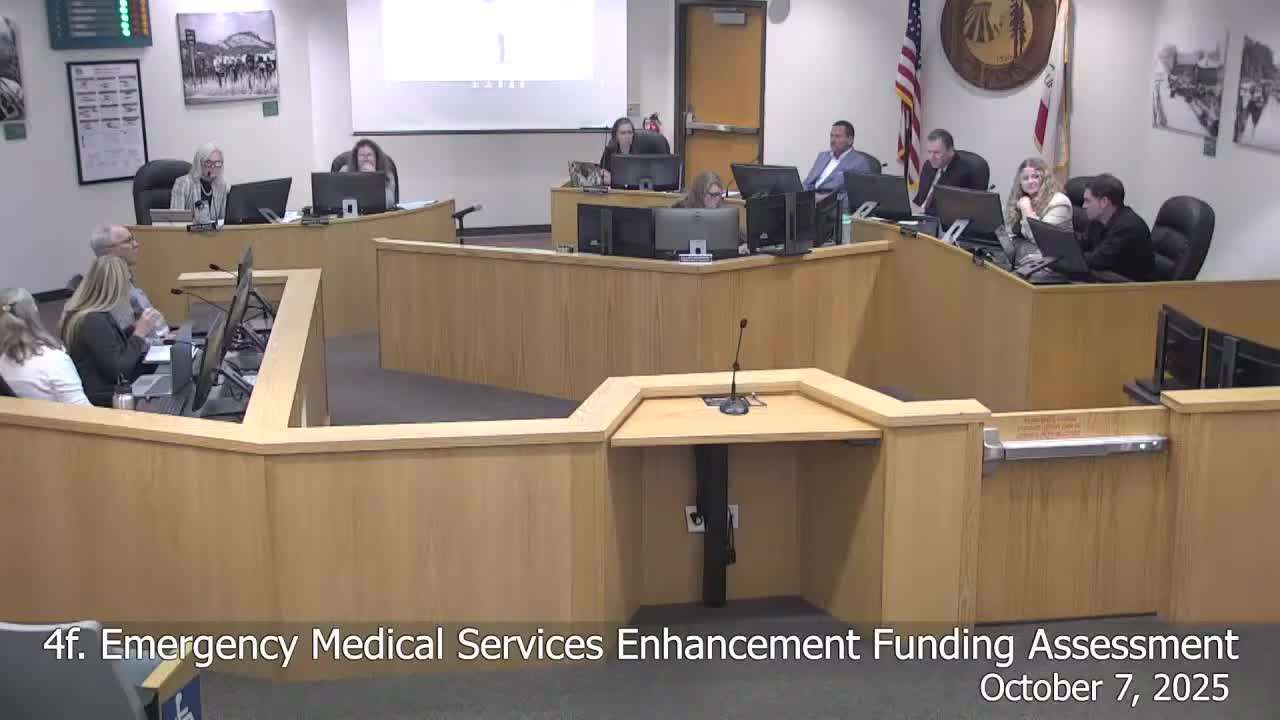County accepts EMS fiscal review for rural ambulances; asks executive office for funding and sales‑tax analysis
October 08, 2025 | Mendocino County, California
This article was created by AI summarizing key points discussed. AI makes mistakes, so for full details and context, please refer to the video of the full meeting. Please report any errors so we can fix them. Report an error »

Mendocino County supervisors on Oct. 7 received a fiscal assessment of three rural ambulance providers — Covelo, Laytonville and Anderson Valley — and directed the Executive Office to return with a summary of available one‑time funds and an estimate of revenue a 1% countywide sales tax would generate to support emergency medical services. The board also asked county counsel to advise whether a countywide sales tax could be used for fire and EMS funding.
The assessment, prepared by Coastal Valleys EMS in coordination with local fire districts, found chronic structural shortfalls driven by low reimbursement rates, a high share of Medicare/Medi‑Cal or uninsured patients, and staffing pressures. Coastal Valleys reported that Covelo’s ambulance division faces the largest gap — an estimated annual shortfall of roughly $900,000 — and that Laytonville runs a recurring deficit roughly in the $191,000–$216,000 range despite higher gross billings. Anderson Valley has a smaller gross base but suffers revenue erosion from unpaid rendezvous transfers and an unfavorable payer mix.
Why it matters: County subsidies and modest enhancement stipends (the county pays roughly $66,000 per provider) were identified as essential backstops; without them, local ambulance coverage would be at material risk. Coastal Valleys staff told the board that reimbursement programs (including GEMT/IGT and federal support) remain uncertain and that reliance on volunteers has declined, which increases each district’s payroll burden.
Board direction and next steps: The board voted unanimously to direct the Executive Office to report back with available PG&E/one‑time funds set aside for EMS/JPA planning and to provide a countywide 1% sales‑tax revenue estimate; county counsel was asked to advise whether revenue collected could legally be used for fire and EMS. The motion also requested that Coastal Valleys and local fire partners bring ideas for use of any proposed funding. CEO staff said they would check balances from prior PG&E allocations and return with a preliminary estimate at the Nov. 4 meeting.
Support and context: Jen Banks of Coastal Valleys EMS summarized the key drivers of the deficits — payer mix, low Medicare/Medi‑Cal rates for ground transport, and uncompensated ALS rendezvous transfers that leave BLS agencies with unreimbursed work. She urged the board to consider options beyond small stipends, including stable local revenue mechanisms or a regional joint powers authority. Esther Adair of County OES introduced the presentation and noted the EMS oversight transition to Public Health Preparedness effective Oct. 1.
Ending: Supervisors said a countywide discussion and a precise dollar estimate would be necessary before placing any funding measure on a ballot. Several supervisors signalled they prefer a countywide solution rather than piecemeal, parcel‑by‑parcel assessments. The executive office and county counsel will return with the requested financial and legal analysis.
The assessment, prepared by Coastal Valleys EMS in coordination with local fire districts, found chronic structural shortfalls driven by low reimbursement rates, a high share of Medicare/Medi‑Cal or uninsured patients, and staffing pressures. Coastal Valleys reported that Covelo’s ambulance division faces the largest gap — an estimated annual shortfall of roughly $900,000 — and that Laytonville runs a recurring deficit roughly in the $191,000–$216,000 range despite higher gross billings. Anderson Valley has a smaller gross base but suffers revenue erosion from unpaid rendezvous transfers and an unfavorable payer mix.
Why it matters: County subsidies and modest enhancement stipends (the county pays roughly $66,000 per provider) were identified as essential backstops; without them, local ambulance coverage would be at material risk. Coastal Valleys staff told the board that reimbursement programs (including GEMT/IGT and federal support) remain uncertain and that reliance on volunteers has declined, which increases each district’s payroll burden.
Board direction and next steps: The board voted unanimously to direct the Executive Office to report back with available PG&E/one‑time funds set aside for EMS/JPA planning and to provide a countywide 1% sales‑tax revenue estimate; county counsel was asked to advise whether revenue collected could legally be used for fire and EMS. The motion also requested that Coastal Valleys and local fire partners bring ideas for use of any proposed funding. CEO staff said they would check balances from prior PG&E allocations and return with a preliminary estimate at the Nov. 4 meeting.
Support and context: Jen Banks of Coastal Valleys EMS summarized the key drivers of the deficits — payer mix, low Medicare/Medi‑Cal rates for ground transport, and uncompensated ALS rendezvous transfers that leave BLS agencies with unreimbursed work. She urged the board to consider options beyond small stipends, including stable local revenue mechanisms or a regional joint powers authority. Esther Adair of County OES introduced the presentation and noted the EMS oversight transition to Public Health Preparedness effective Oct. 1.
Ending: Supervisors said a countywide discussion and a precise dollar estimate would be necessary before placing any funding measure on a ballot. Several supervisors signalled they prefer a countywide solution rather than piecemeal, parcel‑by‑parcel assessments. The executive office and county counsel will return with the requested financial and legal analysis.
View full meeting
This article is based on a recent meeting—watch the full video and explore the complete transcript for deeper insights into the discussion.
View full meeting
